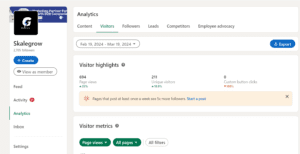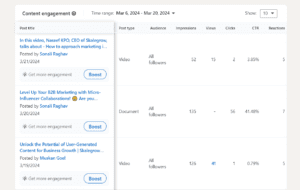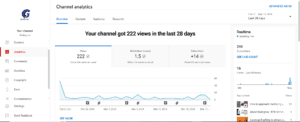Data-driven marketing is a hot topic in B2B. However, I often feel that we all tend to overcomplicate it by attempting to unify data streams and visualizations. As someone who started his career as a marketing analytics professional, I have gone through the pain of filling in missing data points in an attempt to create a single dashboard for the entire marketing team.
I am not saying that a unified dashboard won’t help. As the volume and diversity of your data increase, at some point, you might have to consider building one. But it’s an overkill for most businesses, especially for small to mid-size companies.
Hence, in this article, we discuss a simplified approach startups and SMBs in the B2B space can take to look at marketing through the lens of data.
Before we start
I have spoken about data-driven marketing in some of my articles before. Here are a couple of good reads when it comes to measuring the success of your marketing and branding activities:
- Metrics you should measure to assess the effectiveness of your B2B marketing efforts
- 10 metrics to measure the brand awareness and reach of your B2B business
This article will have some overlap with the above two in terms of the metrics we cover. But today, we take a more holistic (and simplistic) approach to data-driven marketing by covering the most critical channels and metrics you should look at.
Note: A lot of the points we cover today are going to be very basic. At the same time, there will be details and nuances associated with the topic that you might find useful.
The essence of the simplistic data-driven marketing model
As I mentioned above, one of the challenges I see with the approach toward data-driven marketing is that we try to build a perfect model – with end-to-end customer journeys, new-age attribution models, multiple levels of correlations, etc.
But trust me. You don’t need those sophisticated models to succeed in marketing, especially in the early days of your business. Instead, what you can (and should) do is focus on growth-driven metrics that come in two forms:
- On-platform metrics
- Business metrics
On-platform metrics are the parameters the platform you are using to promote your content offers. For example, if LinkedIn is one of your channels, number of followers, average number of post impressions, engagement rate, etc., are examples of on-platform metrics.
On the other hand, business metrics are about measuring what impact your marketing activities are having on the overall growth of the business. The total pipeline a business has managed to generate over a given period of time is an example.
But isn’t this very obvious? We all knew this, didn’t we?
Here’s the thing. I observe a phenomenon called ‘attribution mirage’ where B2B marketing leaders get obsessed with attributing every single lead to a channel or source. A company operating with a revenue of say less than $50 million will find this impractical because of the following reasons:
- To set up a system for doing a near-perfect attribution will need people, tools, and expertise that don’t come cheap.
- Building a solid attribution system would take weeks of effort, even with an experienced marketing analytics/ops professional.
- Many a time, you will unnecessarily spend time trying to fix data issues.
As an SMB, spending your valuable time and resources on these activities comes with high opportunity costs. You should rather be focusing on building the fundamentals of the business (like winning customers, offering a stellar product experience, improving retention, etc.).
So, the point is, look at marketing data from a growth and audience building standpoint initially. When you reach a stage where you think you can afford to be obsessed with attribution, go for it (read more about how to build a B2B revenue attribution system here).
How to apply data-driven marketing as a B2B SMB?
Now that we understand the fundamental principle behind the simplified data-driven marketing model, let’s learn how to implement it right.
There are primarily three things you should consider while developing a data-driven approach to marketing in B2B companies:
- What types of data to look at?
- How frequently should you look at the data?
- What are the tools and processes you need to have in place to implement data-driven marketing?
1. Data types to measure and analyze
As discussed above, there are broadly two types of marketing metrics you need to look at – on-platform metrics and business metrics.
Let’s start with on-platform metrics.
Since the idea is to take into account only those data points that matter to a business the most, following are the platforms you need to focus on when it comes to on-platform metrics
- YouTube
- Paid ads (assuming you are running ads)
- Website
- Any other content assets and channels
LinkedIn metrics
On LinkedIn, there are 5 categories of metrics you need to analyze as shown in the image below: visitors, followers, leads, content, and competitors.

As an example, let us dive deep into content. As shown in the image below, you will be able to see impressions, clicks, CTR, and reactions for every post.

In addition to looking at these numbers once in a while, it is also key to track progress over time – whether it’s number of followers, content reach, or page visitors.
Related: LinkedIn Outreach – 7 Ways To Optimize It Using Personalization
YouTube metrics
On YouTube, at a channel level, there are 3 types of metrics you can analyze – content, audience, and research.

Under content, you will be able to see metrics like impressions, clicks, CTR, and average view duration. While the audience tab shows the demographic information of your audience as a whole, the research tab tells you what kind of keywords your users are searching for on YouTube. You can also use the research tab to find the keywords that have a high volume in your niche.
In addition to these, for individual videos, you can analyze metrics like views, likes & dislikes, comments, etc.
Paid ads
In paid ads, depending on the platform you use, metrics might vary slightly. But some of the common types of numbers you would analyze are impressions, clicks, CTR, total cost of the campaign, average cost per conversion, etc.
Also read: Using Paid Ads For B2B Demand Generation – Doing It The Counterintuitive Way
Email marketing metrics
To optimize your email campaigns for the best results, you need to measure the following metrics:
- Delivery rate
- Open rate
- Number of soft and hard bounces
- Click rate and click-through rate
- Reply rate and positive reply rate
For further reading: 5 B2B Email Marketing Hacks You Should Try In 2024
Website metrics
Measuring website-related metrics is a very vast topic. From traffic data to SEO-related info and user behavior analysis, there is plenty of data to consider. But the simplified data-driven marketing model involves measuring two types of metrics:
- Website traffic data
- SEO performance
If you are using Google Analytics 4 for measurement, website traffic data would involve analyzing data points like users, new users, average time on page, number of events, etc. You can do this for the entire website or for specific pages.
Measuring SEO performance can be done using metrics like domain rating, number of backlinks and referring domains, organic keywords, etc.

There could be minor variations depending on the tool you use for analysis (the above data was obtained using Ahrefs).
Learn more about SEO: Getting Started With SEO-led Content In 3 Days
Other content assets and channels
This would vary from business to business. Some might have a newsletter, while a few other businesses might be running PR campaigns. While a newsletter will have similar metrics to that of email (except for subscriber-related numbers), a PR campaign can have a wide variety of metrics depending on your objective – such as content reach, number of stories published, number of social media mentions, etc.
Essentially, whatever channel or platform you are using, you choose the data points and parameters accordingly.
Next, let us look at business metrics.
These will heavily depend on the objectives the senior management and leadership have set for the marketing team. It can range from revenue and pipeline to MQLs (Marketing Qualified Leads) and SQLs (Sales Qualified Leads).
Some of the other key business-driven metrics associated with marketing include:
- ROI (Return On Investment)
- CAC (Customer Acquisition Cost)
- LTV (Life Time Value) to CAC ratio
These metrics, again, could vary based on the niche you are in.
2. Frequency of data analysis
Since not every data is the same, you need not look at every metric on a day-to-day basis.
This is my take on this:
For campaigns and channels that have a fast turnaround and a lot is at stake, look at the metrics on a daily basis. Examples include paid ads and email campaigns.
Paid ads because you are spending money every day to get customers. If you don’t optimize and adapt your campaigns quickly based on the insights you get, you might end up burning a lot of cash.
The reason why emails fall into this category is because they reach your prospects’ inboxes directly. You don’t have to wait weeks to see if a campaign is working or not.
On the other hand, SEO and video-related data need not be analyzed every single day (unless you are a large business operating at a scale that requires you to check changes in short time intervals).
3. Tools and processes needed to implement data-driven marketing for SMBs
We have already touched upon this when we discussed the different metrics to consider. But let me list them down again with a few additions.
- LinkedIn native platform (use a social media analytics tool like Hootsuite or SHIELD if needed).
- YouTube: native platform + a YouTube SEO tool like VidIQ or Tubebuddy.
- Paid ads: native ad platform.
- Email: Email/marketing automation tool.
- Website: Google Analytics 4, SEMRush/Ahrefs.
Business metrics can be measured using the data you have in your CRM. You might have to read your CRM data along with a few other data points to draw the complete picture of business metrics.
When it comes to processes, you need to do the following:
- Implement the tools needed to measure data the right way.
- Have a marketing ops/automation professional to implement and maintain the tools.
- Have proper documentation and guidebooks for measuring and analyzing data.
- Above all, develop a mindset to consistently measure data and make improvements based on the insights you get.
Final words
A simplified model doesn’t necessarily mean a fewer number of metrics. It means that you measure only those things which matter the most to the business.
However, there are many more metrics we have not covered in the article, some of which could be important for your business. As in the case of anything else in marketing, a ‘one size fits all’ approach doesn’t work in data-driven marketing as well.
So make sure you adapt this model to what works for your business context the best. Please feel free to reach out to me in case you need any help.
Skalegrow – B2B content marketing agency
With marketing getting tougher and tougher, every wrong foot you make might hamper your growth. What you need is the right guidance and a helping hand. This is where Skalegrow can make a sea of difference.
Skalegrow helps IT, tech, SaaS, and embedded systems companies leverage new-age marketing tactics to grow their business. Check out the below intro video to learn more about what Skalegrow brings to the table:
Content marketing is one of our focus areas and we are already helping some of our clients generate leads and improve brand awareness using high-quality content. Visit our content marketing services page to learn more about how we can help. You could also write to us at info@skalegrow.com.
About the author

Naseef KPO is the Founder and CEO of Skalegrow. He comes with rich experience across multiple areas of B2B marketing including content marketing, demand generation, SEO, account-based marketing, marketing analytics, revenue attribution, marketing technology, etc. He writes thought-provoking and relevant articles on The Skalegrow Blog and his weekly LinkedIn newsletter Elevate Your Marketing.
Prior to starting Skalegrow, Naseef led large marketing teams in multi-million dollar B2B organizations where he made significant contributions to the topline growth of the business. He has also appeared on numerous podcasts where he shared his thoughts on trending marketing topics such as the application of AI in marketing, startup marketing, ABM, and B2B content marketing, just to name a few. Being the founder of Skalegrow, he is currently focusing on helping its clients stay ahead of their competition by using innovative yet practical marketing tactics.
You can connect with Naseef KPO on LinkedIn.


